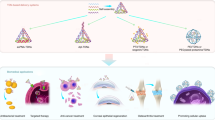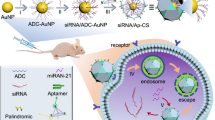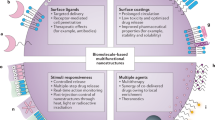Abstract
To improve RNA delivery, we present a protocol to produce an RNA carrier based on a Zn(II)-dipicolylamine (Zn-DPA) analog, which is an artificial receptor for phosphate anion derivatives. We further functionalized this Zn-DPA analog to hyaluronic acid (HA)-based self-assembled nanoparticles (HA-NPs) with a hydrodynamic diameter of 100 nm by conjugating amine-functionalized Zn-DPA molecules onto the HA-NPs through amide formation, resulting in efficient tumor-targeted delivery of RNAs (siRNAs, miRNA or other short oligoribonucleotides) and small-molecule drugs. The functional group of Zn-DPA can be converted into other groups such as a carboxylic or thiol group, and the DPA analog can be covalently attached to a variety of existing and novel platforms or formulations for the development of multifunctional materials via standard bioconjugation techniques. Protocols for RNA formulation and delivery into tumor tissues and tumor cells are also described. Our design strategy offers a versatile and practical method for delivering both RNA and chemotherapeutics to tumor cells and expands existing nanomaterial capabilities to further the field of drug and gene delivery.
This is a preview of subscription content, access via your institution
Access options
Subscribe to this journal
Receive 12 print issues and online access
$259.00 per year
only $21.58 per issue
Buy this article
- Purchase on Springer Link
- Instant access to full article PDF
Prices may be subject to local taxes which are calculated during checkout








Similar content being viewed by others
References
Elbashir, S.M. et al. Duplexes of 21-nucleotide RNAs mediate RNA interference in cultured mammalian cells. Nature 411, 494–498 (2001).
de Fougerolles, A., Vornlocher, H.P., Maraganore, J. & Lieberman, J. Interfering with disease: a progress report on siRNA-based therapeutics. Nat. Rev. Drug Discov. 6, 443–453 (2007).
Dykxhoorn, D.M., Palliser, D. & Lieberman, J. The silent treatment: siRNAs as small molecule drugs. Gene Ther. 13, 541–552 (2006).
Jaroff, L. Fixing the genes. TIME (Jan. 11, 1999).
Whitehead, K.A., Langer, R. & Anderson, D.G. Knocking down barriers: advances in siRNA delivery. Nat. Rev. Drug Discov. 8, 129–138 (2009).
Liu, G., Swierczewska, M., Lee, S. & Chen, X. Functional nanoparticles for molecular imaging guided gene delivery. Nano Today 5, 524–539 (2010).
Yoo, J.W., Irvine, D.J., Discher, D.E. & Mitragotri, S. Bio-inspired, bioengineered and biomimetic drug delivery carriers. Nat. Rev. Drug Discov. 10, 521–535 (2011).
Tseng, Y.C., Mozumdar, S. & Huang, L. Lipid-based systemic delivery of siRNA. Adv. Drug Deliv. Rev. 61, 721–731 (2009).
Bolcato-Bellemin, A.L., Bonnet, M.E., Creusat, G., Erbacher, P. & Behr, J.P. Sticky overhangs enhance siRNA-mediated gene silencing. Proc. Natl. Acad. Sci. USA 104, 16050–16055 (2007).
Liu, G. et al. Sticky nanoparticles: a platform for siRNA delivery by a bis(zinc(II) dipicolylamine)-functionalized, self-assembled nanoconjugate. Angew Chem. Int. Ed. Engl. 51, 445–449 (2012).
Choi, K.Y. et al. Versatile RNA interference nanoplatform for systemic delivery of RNAs. ACS Nano 8, 4559–4570 (2014).
Lee, J.H., Jeong, A.R., Jung, J.H., Park, C.M. & Hong, J.I. A highly selective and sensitive fluorescence sensing system for distinction between diphosphate and nucleoside triphosphates. J. Org. Chem. 76, 417–423 (2011).
Rhee, H.W. et al. A bifunctional molecule as an artificial flavin mononucleotide cyclase and a chemosensor for selective fluorescent detection of flavins. J. Am. Chem. Soc. 131, 10107–10112 (2009).
Rhee, H.W. et al. Detection of kinase activity using versatile fluorescence quencher probes. Angew Chem. Int. Ed. Engl. 49, 4919–4923 (2010).
Kwon, T.H., Kim, H.J. & Hong, J.I. Phosphorescent thymidine triphosphate sensor based on a donor-acceptor ensemble system using intermolecular energy transfer. Chemistry 14, 9613–9619 (2008).
Smith, B.A. et al. Optical imaging of mammary and prostate tumors in living animals using a synthetic near infrared zinc(II)-dipicolylamine probe for anionic cell surfaces. J. Am. Chem. Soc. 132, 67–69 (2010).
Bae, S.W. et al. Apoptotic cell imaging using phosphatidylserine-specific receptor-conjugated Ru(bpy)32+-doped silica nanoparticles. Small 6, 1499–1503 (2010).
Xie, J., Lee, S. & Chen, X. Nanoparticle-based theranostic agents. Adv. Drug Deliv. Rev. 62, 1064–1079 (2010).
Choi, K.Y., Liu, G., Lee, S. & Chen, X. Theranostic nanoplatforms for simultaneous cancer imaging and therapy: current approaches and future perspectives. Nanoscale 4, 330–342 (2012).
Yu, M.K., Park, J. & Jon, S. Targeting strategies for multifunctional nanoparticles in cancer imaging and therapy. Theranostics 2, 3–44 (2012).
Choi, K.Y. et al. Self-assembled hyaluronic acid nanoparticles for active tumor targeting. Biomaterials 31, 106–114 (2010).
Choi, K.Y. et al. PEGylation of hyaluronic acid nanoparticles improves tumor targetability in vivo. Biomaterials 32, 1880–1889 (2011).
Choi, K.Y. et al. Smart nanocarrier based on PEGylated hyaluronic acid for cancer therapy. ACS Nano 5, 8591–8599 (2011).
Platt, V.M. & Szoka, F.C. Jr. Anticancer therapeutics: targeting macromolecules and nanocarriers to hyaluronan or CD44, a hyaluronan receptor. Mol. Pharm. 5, 474–486 (2008).
Choi, K.Y., Saravanakumar, G., Park, J.H. & Park, K. Hyaluronic acid-based nanocarriers for intracellular targeting: interfacial interactions with proteins in cancer. Colloids Surf. B Biointerfaces 99, 82–94 (2012).
Shapira, A., Livney, Y.D., Broxterman, H.J. & Assaraf, Y.G. Nanomedicine for targeted cancer therapy: towards the overcoming of drug resistance. Drug Resist. Updat. 14, 150–163 (2011).
Palakurthi, S., Yellepeddi, V.K. & Vangara, K.K. Recent trends in cancer drug resistance reversal strategies using nanoparticles. Exp. Opin. Drug Deliv. 9, 287–301 (2012).
Liu, C. et al. The microRNA miR-34a inhibits prostate cancer stem cells and metastasis by directly repressing CD44. Nat. Med. 17, 211–215 (2011).
Choi, K.Y. et al. Theranostic nanoparticles based on PEGylated hyaluronic acid for the diagnosis, therapy and monitoring of colon cancer. Biomaterials 33, 6186–6193 (2012).
Lee, D.E. et al. Amphiphilic hyaluronic acid-based nanoparticles for tumor-specific optical/MR dual imaging. J. Mater. Chem. 22, 10444–10447 (2012).
Xie, J., Liu, G., Eden, H.S., Ai, H. & Chen, X. Surface-engineered magnetic nanoparticle platforms for cancer imaging and therapy. Acc. Chem. Res. 44, 883–892 (2011).
Mykhaylyk, O., Antequera, Y.S., Vlaskou, D. & Plank, C. Generation of magnetic nonviral gene transfer agents and magnetofection in vitro. Nat. Protoc. 2, 2391–2411 (2007).
Young, J.K., Figueroa, E.R. & Drezek, R.A. Tunable nanostructures as photothermal theranostic agents. Ann. Biomed. Eng. 40, 438–459 (2012).
Stern, R. & Jedrzejas, M.J. Hyaluronidases: their genomics, structures, and mechanisms of action. Chem. Rev. 106, 818–839 (2006).
Pittella, F. et al. Enhanced endosomal escape of siRNA-incorporating hybrid nanoparticles from calcium phosphate and PEG-block charge-conversional polymer for efficient gene knockdown with negligible cytotoxicity. Biomaterials 32, 3106–3114 (2011).
Acknowledgements
This work was supported in part by the National Basic Research Program of China (973 program nos. 2013CB733802 and 2014CB744503), the National Science Foundation of China (nos. 51273165, 81101101 and 81371596), an AXA Research Fund Postdoctoral Fellowship, the National Research Foundation of Korea (NRF) Postdoctoral Fellowship (no. 2013R1A6A3A03) and NRF grant (2009—0080734) from the Ministry of Education, Science and Technology (MEST, Korea), and the Intramural Research Program of the National Institute of Biomedical Imaging and Bioengineering (NIBIB), US National Institutes of Health (NIH).
Author information
Authors and Affiliations
Contributions
S.L. and X.C. conceived and designed the experiments; K.Y.C., G.L., X.H., O.F.S. and N.H. conducted the synthesis, prepared formulas and performed the biological experiments; S.W.L. and J.I.H. provided DPA analogs and summarized synthetic protocols; K.Y.C., D.N.H. and X.C. co-wrote the paper.
Corresponding author
Ethics declarations
Competing interests
The authors declare no competing financial interests.
Integrated supplementary information
Supplementary Figure 1 Chemical structure and 1H NMR spectrum of compound 5.
(300 MHz, CD3OD). δ=3.31(m, 2H), 2.82 (m, 2H), 1.05-0.95 (m, 6H), 0.73(s, 3H)
Supplementary Figure 2 Chemical structure and 1H NMR spectrum of compound 6.
(300 MHz, D2O/CD3OD). δ=6.8-8.3 ppm (methylene groups of the ring structure in bis-DPA), 2.0 ppm (the methyl group at the C2 position of N-acetyl glucosamine in HA), 0.6-1.8 ppm (methyl and methylene groups of the ring structure in CA).This figure is adapted from previously published work and reproduced with permission from ACS Publications.11
Supplementary Figure 3 In vitro characterizations of CaP-HDz/siRNA-NP formulations.
Size distributions (a) and zeta potential results (b) of HDz-NP, HDz/siRNA-NP, Ca-HDz/siRNA-NP and CaP-HDz/siRNA-NP. c, Release of siRNA from HDz/siRNA with the addition of phosphate ions. This figure is adapted from previously published work and reproduced with permission from ACS Publications.11
Supplementary Figure 4 Cellular uptake of RNA complexed CaP-HDz-NPs.
Celluar images of HCT116 cells treated with Cy3-siRNA complexed with CaP-HDz-NP or Lipofectamine 2000 (Lipo2K); CD44-blocked cells treated with CaP-HDz/siRNA or Cy3-siRNA only. Blue (DAPI, nuclei) and red (Cy3-siRNA). The cells treated with CaP-HDz/siRNA exhibited signifinantly stronger fluorescence signal than the cells incubated with Lipo2K/siRNA. After CD44 receptors on the cell surface were blocked by pre-treatment of excess HA molecules, fluorescence signals from siRNA were rarely detected, indicating cell-permeation of CaP-HDz/siRNA is highly dependant on the interaction between HA backbone of the NPs and CD44 cell surface receptors. This figure is adapted from previously published work and reproduced with permission from ACS Publications.11
Supplementary Figure 5 Cellular uptake of RNA/drug incorporated CaP-HDz-NPs.
Multi-channel confocal fluorescence images of HCT116 cells treated with Cy5.5-labeled CaP-HDz-NP complexed with Cy3-siRNA and loaded with Oregon green-conjugated paclitaxel (OG-PTX).Considerable amount of CaP-HDz-NP was internalized into the HCT116 cells along with miRNA and PTX. The three major components (PTX/siRNA/CaP-HDz) were co-localized in the cells at early time points (30 min after the treatement). Scale bar 15 um. This figure is adapted from previously published work and reproduced with permission from ACS Publications.11
Supplementary Figure 6 In vitro RNA transfection effect of CaP-HDz/RNA-NFs.
a, Suppression of fLuc gene expression of 143B-fLuc cells after treatment with siNC only, CaP-HDz-NP/siNC or Lipo2K/siNC fLuc gene expression and viability of 143B-fLuc cells after treatment with siRNA only, CaP-HDz-NP or Lipo2K complexed group at high concentrations. b, cell viability after treatment with siLuc, Lipo2K/siLuc and Cap-HDz/siLuc. c, cell viability after treatment with siNC, Lipo2K/siNC, and CaP-HDz-NP/siNC (*p < 0.005, **p < 0.05). The CaP-HDz-NP group shows less toxicity compared to that of the Lipo2K group. This figure is adapted from previously published work and reproduced with permission from ACS Publications.11
Supplementary information
Supplementary Figure 1
Chemical structure and 1H NMR spectrum of compound 5. (PDF 328 kb)
Supplementary Figure 2
Chemical structure and 1H NMR spectrum of compound 6. (PDF 283 kb)
Supplementary Figure 3
In vitro characterizations of CaP-HDz/siRNA-NP formulations. (PDF 118 kb)
Supplementary Figure 4
Cellular uptake of RNA complexed CaP-HDz-NPs. (PDF 546 kb)
Supplementary Figure 5
Cellular uptake of RNA/drug incorporated CaP-HDz-NPs. (PDF 85 kb)
Supplementary Figure 6
In vitro RNA transfection effect of CaP-HDz/RNA-NFs. (PDF 83 kb)
Rights and permissions
About this article
Cite this article
Choi, K., Silvestre, O., Huang, X. et al. A nanoparticle formula for delivering siRNA or miRNAs to tumor cells in cell culture and in vivo. Nat Protoc 9, 1900–1915 (2014). https://doi.org/10.1038/nprot.2014.128
Published:
Issue Date:
DOI: https://doi.org/10.1038/nprot.2014.128
Comments
By submitting a comment you agree to abide by our Terms and Community Guidelines. If you find something abusive or that does not comply with our terms or guidelines please flag it as inappropriate.



